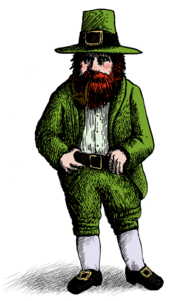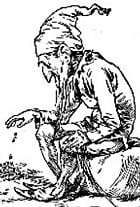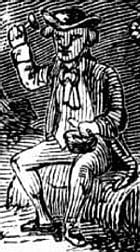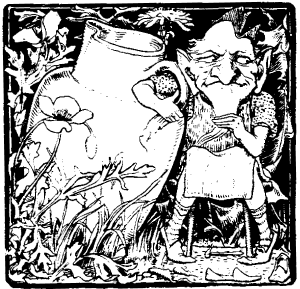Difference between revisions of "Leprechaun" - New World Encyclopedia
Nick Perez (talk | contribs) |
Nick Perez (talk | contribs) |
||
| Line 51: | Line 51: | ||
The modern image of the leprechaun is almost invariant: he is depicted wearing an [[emerald]] green [[frock coat]], and bestowed with the knowledge of the location of buried [[treasure]], often in a [[Crock (dishware)|crock]] of [[gold]]. | The modern image of the leprechaun is almost invariant: he is depicted wearing an [[emerald]] green [[frock coat]], and bestowed with the knowledge of the location of buried [[treasure]], often in a [[Crock (dishware)|crock]] of [[gold]]. | ||
| − | |||
| − | |||
| − | |||
| − | |||
| − | |||
| − | |||
| − | |||
| − | |||
| − | |||
| − | |||
| − | |||
| − | |||
| − | |||
| − | |||
| − | |||
| − | |||
| − | |||
| − | |||
| − | |||
== See also == | == See also == | ||
Revision as of 02:26, 8 March 2007

The most famous, recognizable and misrepresented icon of Irish mythology is the leprechaun. Their mythical origins stretching back to before the arrival of the Celts, the leprechaun has come a long way from a species of faeries or sprites to an almost cartoonish characture of Irish culture that both celebrates and belittle Celtic culture.
Etymology
There are a number of possible etymologies of the name "leprechaun". One of the most widely accepted theories is that the name comes from the Irish Gaelic words leipreachán and 'luchorpán, both of which overlap in definition as "pigmy, a sprite" The Oxford English Dictionary states an alternate origin as being leath bhrógan, meaning shoe-maker — the leprechaun is known as the fairy shoemaker of Ireland and is often portrayed working on a single shoe.[1]

Another derivation has the word "leprechaun" deriving from luch-chromain, meaning "little stooping Lugh", Lugh being the name of a leader of the Tuatha Dé Danann.[2]
The word leprechaun was first recorded used in the English language in 1604 in Middleton and Dekker's The Honest Whore as lubrican. The original meaning was of some kind of spirit and not specifically associated with the Irish mythological character:[3]
Origin
One of the purported origins of leprechaun myths comes from the many "faerie forts" or "faerie rings", earthworks and drumlins, found in Ireland that pre-date the Celt occupation, and is connected to the belief in the Tuatha Dé Danann and other quasi-historical races said to be the original inhabitants of the island. At some point in Ireland's history, the leprechaun become a distinguishable entity from other faeries, recognized as taking the form of old men who enjoyed partaking in mischief. Their trade was believed to be that of a cobbler or shoemaker. They were very rich, having many treasure crocks buried during war-time. [4] It was also believe that if anyone kept an eye fixed upon one, he could not escape, but the moment the eye withdrew he vanished.
In most tales and stories leprechauns are depicted as generally harmless creatures who enjoy solitude and live in remote locations, although opinion is divided as to if they ever enjoy the company of other spirits. Although rarely seen in social situations, leprechauns are supposedly very well spoken and, if ever spoken to, could make good conversation.

Among the most popular of beliefs about leprechauns is that they are extremely wealthy and like to hide their gold in secret locations, which can only be revealed if a person were to actually capture and interrogate a leprechaun for its money. Leprechauns rarely appear in what would be classed as a folk tale; in almost all cases the interest of these stories centres round a human hero. Stories about leprechauns are generally very brief and generally have local names and scenery attached to them. The tales are usually told conversationally as any other occurrence might be told, whereas there is a certain solemnity about the repetition of a folk-tale proper. By nature, leprechauns are said to be ill-natured and mischievous, with a mind for cunning. Many tales present the leprechaun as outwitting a human, as in the following examples.
Examples of tales involving leprechauns
A farmer or young lad captures a leprechaun and forces him to reveal the location of his buried treasure. The leprechaun assures him that the treasure is buried in an open field beneath a particular ragwort plant. The farmer ties a red ribbon to the plant, first extracting a promise from the leprechaun not to remove the ribbon. Releasing the leprechaun, he leaves to get a shovel. Upon his return he finds that every weed in the field has been tied with an identical red ribbon, thus making it impossible to find the treasure.[5] [6]
In another story, a young girl finds a leprechaun and bids him show her the location of his buried money. She takes him up in her hand and sets out to find the treasure, but all of a sudden she hears a loud buzzing behind her. The leprechaun shouts at her that she is being chased by a swarm of bees, but when she looks around there are no bees and the leprechaun has vanished. [7]
In other stories they are told of riding shepherds' dogs through the night, leaving the dogs exhausted and dirty in the morning.
Appearance
The leprechaun originally had a different appearance depending on where in Ireland he was found.[8] Prior to the 20th century, it was generally agreed that the leprechaun wore red and not green. Samuel Lover, writing in the 1831 describes the leprechaun as,
- ... quite a beau in his dress, notwithstanding, for he wears a red square-cut coat, richly laced with gold, waistcoat and inexpressible of the same, cocked hat, shoes and buckles. [9]
Yeats, in his 1888 book entitled Fairy and Folk Tales of the Irish Peasantry describes the leprechaun as follows:
- He is something of a dandy, and dresses in a red coat with seven rows of buttons, seven buttons on each row, and wears a cocked-hat, upon whose pointed end he is wont in the north-eastern counties, according to McAnally, to spin like a top when the fit seizes him.[10]
In a poem entitled The Lepracaun; or, Fairy Shoemaker, the 18th century Irish poet William Allingham describes the appearance of the leprechaun as:
- ...A wrinkled, wizen'd, and bearded Elf,
- Spectacles stuck on his pointed nose,
- Silver buckles to his hose,
- Leather apron - shoe in his lap... [11]
Some commentators accuse Allingham of leaving the legacy of the modern image of the leprechaun described below. [12]
The modern image of the leprechaun is almost invariant: he is depicted wearing an emerald green frock coat, and bestowed with the knowledge of the location of buried treasure, often in a crock of gold.
See also
- Clurichaun ("cousin" of the Leprechaun)
- Far darrig
- Kallikantzaros
- Menehune
- Sprite (creature)
- Cultural appropriation
Notes
- ^ From Fairy and Folk Tales of the Irish Peasantry.
- ^ Dinneen, Patrick, Foclóir Gaedhilge agus Béarla, Dublin: Irish Texts Society, 1927
- ^ Hanks, Patrick, ed. Collins Dictionary of the English Language, London: William Collins Sons & Co. Ltd, 1979
- ^ Oxford English Dictionary (full ed.) (1989).
- ^ Ireland Now - The Leprechauns.
- ^ Oxford English Dictionary (full ed.) (1989).
- ^ The Fairy Mythology by Thomas Keightley - Ireland
- ^ The Field of Boliauns - A typical tale involving a leprechaun printed in the 1800s.
- ^ Clever Tom and the Leprechaun
- ^ The Leprechaun in the Garden
- ^ Little Guy Style
- ^ From Legends and Stories of Ireland
- ^ From Fairy and Folk Tales of the Irish Peasantry.
- ^ William Allingham - The Leprechaun
- ^ Criticism of William Allingham's The Fairies
- ^ From Fairy and Folk Tales of the Irish Peasantry.
- ^ Dáil Éireann - Volume 495 - 20 October, 1998 - Tourist Traffic Bill, 1998: Second Stage.
- ^ Dáil Éireann - Volume 206 - 11 December, 1963 Committee on Finance. - Vote 13—An Chomhairle Ealaoín.
- ^ Dáil Éireann - Volume 206 - 11 December, 1963 Committee on Finance. - Vote 13—An Chomhairle Ealaoín.
- ^ Republican Sinn Féin - AN GHAEILGE Why it is so important
Further reading
- Croker, T. C. (1862) Fairy Legends and Traditions of the South of Ireland
- Yeats, W. B. (1888) Fairy and Folk Tales of the Irish Peasantry — available online here
- McAnally, D. R. (1900) The Leprechawn
- Lover, S. (1831) Legends and Stories of Ireland — available online here
- Hyde, D. (1910) Beside The Fire — available online here
- Keightley, T. (1870) The Fairy Mythology: Illustrative of the Romance and Superstition of Various Countries — available online here
- Wilde, F. S. (1887) Ancient Legends, Mystic Charms, and Superstitions of Ireland — available online here
External links
- The Leprechaun Companion (an illustrated guide)
Credits
New World Encyclopedia writers and editors rewrote and completed the Wikipedia article in accordance with New World Encyclopedia standards. This article abides by terms of the Creative Commons CC-by-sa 3.0 License (CC-by-sa), which may be used and disseminated with proper attribution. Credit is due under the terms of this license that can reference both the New World Encyclopedia contributors and the selfless volunteer contributors of the Wikimedia Foundation. To cite this article click here for a list of acceptable citing formats.The history of earlier contributions by wikipedians is accessible to researchers here:
The history of this article since it was imported to New World Encyclopedia:
Note: Some restrictions may apply to use of individual images which are separately licensed.


